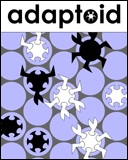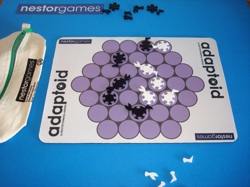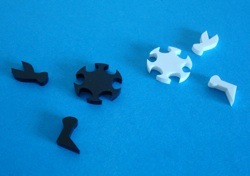
|
About OgreCave and its staff
|

|
by Lee Valentine
AdaptoidPublished by nestorgamesDesigned by Néstor Romeral Andrés €25 (approximately $36.90) Available only direct from the publisher's website
Adaptoid is a new two-player game from indie board game manufacturer nestorgames. Founded by Spanish game designer Néstor Romeral Andrés, nestorgames specializes in making small, portable and mostly abstract board games using an innovative "manufactured on demand" process. Romeral designed Adaptoid himself, and I previously reviewed one of his earlier creations here on OgreCave, Taiji, published by Blue Panther Games.
The Rules
The second phase allows you to add a single game piece to the board. You can either spawn a new limbless Adaptoid to the board in an empty space adjacent to one of your pre-existing Adaptoids, or you can add a pincer or leg to one of your other Adaptoids. During the third phase, all of your opponent's Adaptoids try to feed during your turn (yours feed during your opponent's turn). Each Adaptoid that is feeding must be surrounded by a number of empty spaces on the board equal to its number of limbs or it is captured during this phase and removed from the board. Captures during this phase also score points toward the five points needed for victory.
Game Play Commentary Usually, crucial captures are made by the feeding rules rather than overt combat. The threat of combat forces your opponent to move to undesirable parts of the board (such as the edge) where feeding options are more limited ("off the board" areas do not help to feed your Adaptoid). I liked the game play quite a bit, but I felt that thematically it would be more exciting to win by combat rather than merely starving my opponent's Adaptoids; call it the American in me.
I sometimes wished for more strategic options, but the simplicity of the game was appealing because it allowed me to explain the rules and start playing in about five minutes. This is a game where the first person to make a mistake loses the game almost instantly against a competent opponent. This makes coming back from behind exceedingly difficult. It also tends to result in short games of fifteen minutes to half an hour, which makes Adaptoid a great filler game for two.
Components and Packaging The board itself is a grayscale print job on top of a light, flexible rubber material. The board is not particularly visually appealing, as it is simply an abstract hex pattern with no further detail. It can be rolled up or mangled and it springs back to shape, making it perfect for transport (see a demo video of this in the Links section at the end of this review). A multi-colored board featuring an alien terrain would have been much more evocative, and I missed this attention to detail. My biggest single complaint about the game board, however, was that the hexes were just too small to fully contain an Adaptoid with several limbs, so that adjacent Adaptoids became a bit crowded. The Adaptoids' bodies and their limbs are carved out of acrylic. While the limbs clearly look like what they are meant to represent, the shapes are devoid of detailed features. The body of each Adaptoid doesn't look at all like a creature, but instead looks like a disc with notches cut out of it. The acrylic game pieces are built in a jigsaw puzzle fashion, where limbs are slid flush into slots on the Adaptoid body. Unlike a jigsaw puzzle, the pieces do not quite fit snugly - they are a little loose. This would not be a problem except that the laser cutting process leaves an occasional sharp edge on the Adaptoids that can cause them to snag on the board while you are sliding an Adaptoid around. Infrequently this causes an Adaptoid to fall apart and have to be reassembled at its new destination. The advantage of the component and board design is in their portability and durability. I could level out some lightly damp beach sand and play Adaptoid on it, without fear of harming the game. That's something I'd never even consider with Ticket to Ride, for example.
Conclusions The portability of this game is a real winner here. I could probably carry four to six nestorgames products in the space I would typically use to carry a single standard board game with a quad-fold board. The nestorgames motto is "fun to take away", and I think it's a solid, short description of Adaptoid. The only issue that I find to really detract from the game is its price point. It is available only direct from the publisher for a price of €25 (about $36.90 in the U.S.). Add in shipping, and the price rises to around $44.00. That's enough to buy many hobby board games with more components and higher production values from your local game store. Clearly the value for the money is somewhat better in Europe (because of the current weak value of the U.S. dollar overseas). Higher price points are not unusual for indie games (particularly for indie RPGs), so this may not deter serious game collectors. I recommend this game to fans of fast, abstract games and positional strategy games, and particularly to gamers in the European Union who can take advantage of more favorable pricing. Having enjoyed all of Romeral's designs that I have seen to date, I look forward to playing and reviewing his future creations.
Lee's Ratings: Links
|
||||

 During a player's turn he completes three standard phases. The first
phase is the movement and capture phase. A player may move each of his
Adaptoids that have legs. Each Adaptoid may move a number of spaces
equal to its number of legs. If it lands on another Adaptoid, combat
occurs: the Adaptoid with the fewest pincers in the combat is removed
from the board; in a tie, both Adaptoids are removed. When you capture
an opponent's Adaptoid in this fashion, you score a point. When you get
to five points you win the game. You also win if, at any time, your
opponent has no Adaptoids on the board.
During a player's turn he completes three standard phases. The first
phase is the movement and capture phase. A player may move each of his
Adaptoids that have legs. Each Adaptoid may move a number of spaces
equal to its number of legs. If it lands on another Adaptoid, combat
occurs: the Adaptoid with the fewest pincers in the combat is removed
from the board; in a tie, both Adaptoids are removed. When you capture
an opponent's Adaptoid in this fashion, you score a point. When you get
to five points you win the game. You also win if, at any time, your
opponent has no Adaptoids on the board.
 What was interesting about the feeding mechanic was that while Adaptoids
with more limbs were extremely powerful, they typically couldn't survive
for long. Once an Adaptoid has more than four limbs they become
exceptionally easy to starve. With five or six limbs it is actually
pretty easy to accidentally starve your super-Adaptoid all by yourself
by being over-eager and moving to the edge of the board or too close to
one of your other Adaptoids.
What was interesting about the feeding mechanic was that while Adaptoids
with more limbs were extremely powerful, they typically couldn't survive
for long. Once an Adaptoid has more than four limbs they become
exceptionally easy to starve. With five or six limbs it is actually
pretty easy to accidentally starve your super-Adaptoid all by yourself
by being over-eager and moving to the edge of the board or too close to
one of your other Adaptoids.